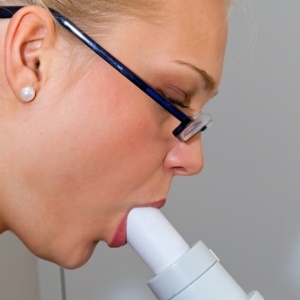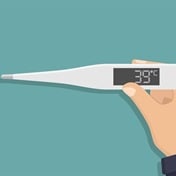
Alternative names
Pulmonary function tests (PFT), peak flow
What are lung function test (PFT)?
There are a variety of lung function tests available which examine different aspects which can be broadly divided into airflow, lung size and gas exchange. Lung function tests are used to help diagnose certain lung conditions, and to monitor response to treatment. Depending on the problem, certain tests may be used, as not all tests examine all aspects.
- Peak flow meter
This device is a cylindrical tube into which one has to blow out as hard and as fast as possible. It only measures how fast the air can be blown out. This test is most useful in asthma and smoking related lung disease (COPD) as in these conditions the airflow is usually reduced proportionally to the severity of the disease.
- Spirometry
This test is often done as a screening test for lung disease prior to any major surgical operation. It requires one to blow out as hard as possible until your lungs are completely empty. It measures the volume of air blown out in 1 second (FEV 1) and the total volume blown out (FVC). This gives a ratio which is used to define if there is obstruction to air flow or a reduction in lung volume.
- Flow volume loop
This test requires specialised equipment, which is usually only available to a specialist. This is the basic test a lung specialist will use to evaluate all lung diseases as it gives the most information in one test. It measures both the rate of airflow as well as the total volume of air breathed. It requires one to breathe out as fast as possible, until all the air has been expelled and then breathe in again until the lungs are full. The computer is able to then draw a graph of the flow- it has a characteristic shape depending on the problem. Although more complicated, it provides the specialist with much more information relating to the lung size and air flow.
D. Diffusion capacity/Transfer factor
This specialised test evaluates how well the lungs are able to exchange oxygen and carbon dioxide with the blood. In certain lung diseases such as sarcoid or pulmonary fibrosis, gas exchange can be very poor with relatively normal airflow and lung volumes. To do this test one is usually required to breathe in a special mixture of gases, hold your breath for 10 seconds and then breathe out.
E. Full lung volumes/ Body box, Body plethysmography
This test is only available at a specialist and is not often performed. The machine looks like a telephone booth in which one sits and breathes in and out of a mouth piece. It is able to measure detailed aspects of the entire lung volume. It is usually used if major surgery to the lung is required or before a lung transplant.
Do I need to prepare for it and what are the risks involved?
No preparation is required prior to these tests and you can eat and drink tea or coffee. It is best to avoid using your inhaler (if you can) prior to the test. There are generally no risks involved, although it can be quite tiring to perform all the tests. Your doctor or the respiratory technologist doing the test will explain exactly what to do and coach you through it.
Author: Dr Richard van Zyl-Smit (Specialist Physician and Pulmonologist)
Qualifications: MBChB MRCP( UK) FCP(SA) MMED Cert Pulm(SA)




 Publications
Publications
 Partners
Partners















